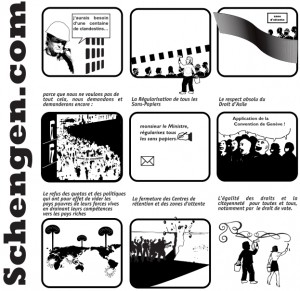 Bande dessinée sur la politique migratoire a l’heure de la forteresse Schenghen –
Bande dessinée sur la politique migratoire a l’heure de la forteresse Schenghen –
Télécharger le pdf: schengen
 Bande dessinée sur la politique migratoire a l’heure de la forteresse Schenghen –
Bande dessinée sur la politique migratoire a l’heure de la forteresse Schenghen –
Télécharger le pdf: schengen
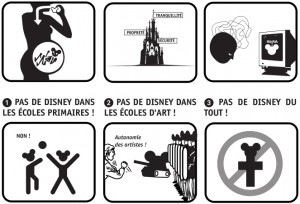 Download Comics – disney
Download Comics – disney
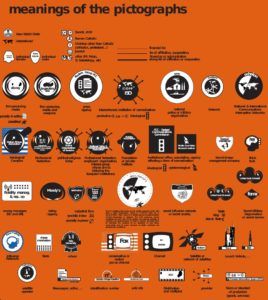 Dowload map – medias_skill2004
Dowload map – medias_skill2004
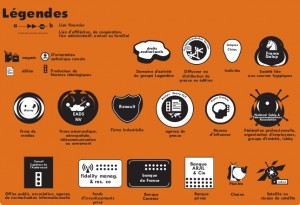 Cette carte a été réalisé dans le cadre de la coopérative Co-errances pour la diffusion et distribution de livres, revues, films et disques. Cette coopérative visait le développement d’un réseau de distribution indépendant des réseaux contrôlés en France par le groupe de médias le plus puissant à l’époque : le groupe Lagardère.
Cette carte a été réalisé dans le cadre de la coopérative Co-errances pour la diffusion et distribution de livres, revues, films et disques. Cette coopérative visait le développement d’un réseau de distribution indépendant des réseaux contrôlés en France par le groupe de médias le plus puissant à l’époque : le groupe Lagardère.
Ce groupe – qui contrôlait en totalité ou en partie 70 à 80% des magazines et revues en France, une bonne partie des livres scolaires et des grands éditeurs, des radios, des télévisions et sociétés de production de films, des réseaux de distribution de presse, etc. – était, et est encore aujourd’hui le plus grand groupe producteur d’armement en Europe.
L’ironie du sort a voulu que cette carte sorte dans les kiosques le jour de la mort de Jean-Luc Lagardère, fondateur du groupe Lagardère (aujourd’hui dirigé par son fils).
Diffusée par les Inrockuptibles à 30 000 exemplaires, nous avons eu la surprise de remarquer que, contrairement à nos attentes, elle ne suscita AUCUNE réaction du publique, ni des magazines et médias qui auraient pu y faire référence. Le groupe Lagardère lui-même, hormis un appel d’une responsable de la communication qui voulait connaître l’origine de cette carte, n’a eu qu’indifférence pour ce travail que nous voulions critique, et capable de susciter le débat sur le contrôle et la concentration des médias en France.
Download map – lagardere2004
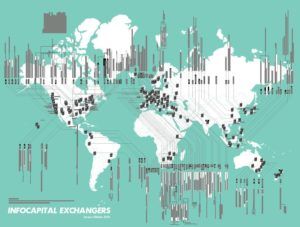 The American military network ARPAnet was conceived as a way to maintain uninterrupted communications in the event of nuclear war. Ancestor of the Internet and foundation of the Global Information Infrastructure, ARPAnet springs from exactly the same source as the “push-button war” that lay behind it: the change of scale provoked by the early 20th century discoveries in physics, within an industrial society capable of organizing the productivity – including the scientific productivity – of thousands of agents. Here, no doubt, is the real birthplace of the information society: a society massively penetrated by the sciences and technologies of information and telecommunications, using them to carry out the design of the planet or at least, that of its components (with design replacing politics). A society whose governmentality entails the knowledge of the real, that is to say, the transformation of reality into information. A society whose governmentality unfolds between its smallest common denominators (atomic, electronic, magnetic, genetic, chemical) and its largest common denominators (climate, planet, solar system), by way of laws, formulas and norms that determine its productivity, means, and possible destinies. (…)
The American military network ARPAnet was conceived as a way to maintain uninterrupted communications in the event of nuclear war. Ancestor of the Internet and foundation of the Global Information Infrastructure, ARPAnet springs from exactly the same source as the “push-button war” that lay behind it: the change of scale provoked by the early 20th century discoveries in physics, within an industrial society capable of organizing the productivity – including the scientific productivity – of thousands of agents. Here, no doubt, is the real birthplace of the information society: a society massively penetrated by the sciences and technologies of information and telecommunications, using them to carry out the design of the planet or at least, that of its components (with design replacing politics). A society whose governmentality entails the knowledge of the real, that is to say, the transformation of reality into information. A society whose governmentality unfolds between its smallest common denominators (atomic, electronic, magnetic, genetic, chemical) and its largest common denominators (climate, planet, solar system), by way of laws, formulas and norms that determine its productivity, means, and possible destinies. (…)
Map in english “governing by network”
Map in english “infocapital exchangers”
Text in english “governementality”
Texte in french “gouvernementalite”
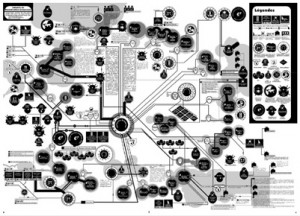 “First of all they’ve got to start by knowing how the system works… We can advise them on how they should put their argument on paper. We can advise them on which people in the committee would be interested… So that way you build a map for them, a sort of road map of where they need to go, who they need to talk to and what they need to know… We don’t do the lobbying… What we do is to give the company the information so that they can go and make the case for themselves.”
“First of all they’ve got to start by knowing how the system works… We can advise them on how they should put their argument on paper. We can advise them on which people in the committee would be interested… So that way you build a map for them, a sort of road map of where they need to go, who they need to talk to and what they need to know… We don’t do the lobbying… What we do is to give the company the information so that they can go and make the case for themselves.”
Alan Watson, European Chairman of the world’s largest public relations firm, Burson-Marsteller
Absent from the local landscape, invisible to the naked eye, a labyrinth of laws and standards lends tangible form to our existence. The European Union, like the North American Free Trade Area which it mirrors, is an attempt to produce the world we live in. The instruments it uses are norms: industrial standards, territorial models, ideological guidelines, truth criteria. These become the second nature of an expanding, accelerating drive to make this vast, unpredictable human region into a playground for capitalism.
Sophisticated services have now arisen to lead corporations through the tangle of agencies that their own lobbies helped to create, as a smokescreens to hide and further their interests. This map is a radical opposite to such a secretive, pay-per-view approach to the European institutions. The aim of this research is to help open the public eye – and our own eyes first of all – to the ways that private businesses and prestigious influence groups are able to shape the priorities of the Brussels bureaucracy, while making use of every bit of manufactured fear and every shred of manipulated belief as pretexts to advance their agendas. Of course, what you see here is not even half of it – just the paper-thin surface of the huge iceberg that we’re all about to run in to.
Who are we then? Take your pick. Among the pearls of EU normalese is the phrase “organised civil society.” The dream of the technocrats is to create a perfect fit between all those regulatory agencies, standards bureaus, relay networks, implementation teams, and you: the perfect European worker-consumer. Of course you’ll have a voice in everything concerning your profession, religion or ethnicity. Today there is approximately 1 representative in parliament for every 600,000 Europeans. So who’s producing here? Who’s dreaming? We prefer the other side of the map. Autonomous existences. Solidarity and the taste of freedom. (Brian Holmes, introduction à la publication « European norms of world-production », 2002)
Map EuropeENGbig (complete version)
Map EuropeENG (simplified version)
Carte EuropeFR (version simplifiée)
 Download map – Worldmedia2003
Download map – Worldmedia2003
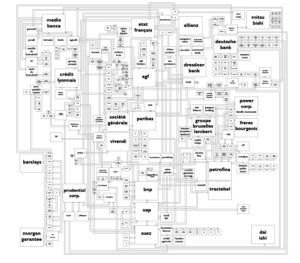 Map Financial Industrial Complex in english.
Map Financial Industrial Complex in english.
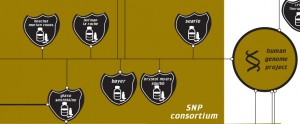 Dowload map – biopharmaComplex
Dowload map – biopharmaComplex
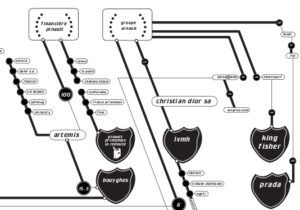 Download Carte pdf – mediaIndustrialComplex2002
Download Carte pdf – mediaIndustrialComplex2002